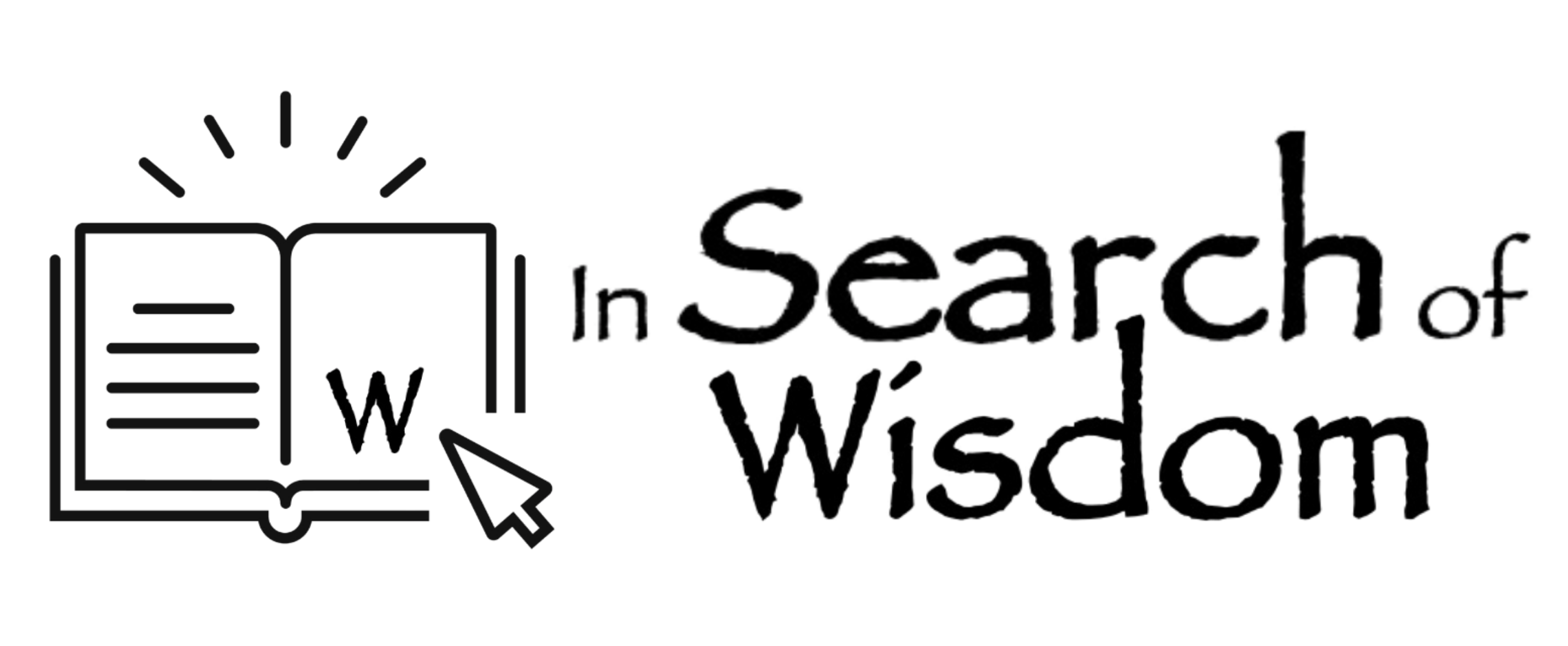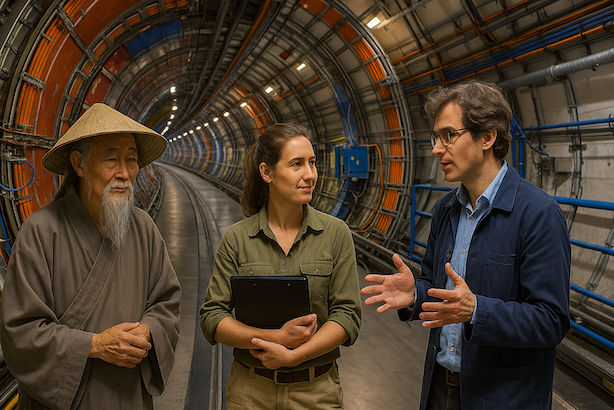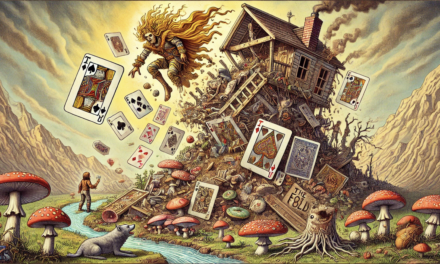Executive Summary
For centuries, contemplatives and scientists have pursued truth along seemingly separate paths: one through direct inner observation, the other through empirical investigation of the external world. Yet both have now converged on a profound common recognition: existence is fundamentally relational, and the apparent separation between self and world is a useful convention, not an ontological truth.
Mystics across traditions—Advaita Vedanta, Mahayana Buddhism, Taoism, Christian and Sufi mysticism—have long described an awareness in which subject and object arise together within undivided reality. Modern science, from quantum physics to ecology and complexity theory, now describes the same pattern: what we call “things” are stable relationships within energy flows; observer and observed cannot be separated; systems persist only through participation in larger wholes.
This convergence exposes the pathology of separation that defines modern civilisation. When we treat humanity as separate from Earth, mind from matter, or individual from community, we create ecological overshoot, social inequality, and psychological distress. These crises are not merely moral or technical—they are developmental symptoms of a species that has mistaken symbolic abstraction for reality.
Humanity now faces a choice: to mature from adolescent autonomy toward adult participation. Maturation means integrating symbolic intelligence within relational understanding—re-embedding our systems, technologies, and selves within the networks of life that sustain us.
Science provides the empirical grounding; contemplative traditions offer the experiential method. Together they form a practical wisdom of recognition: seeing through the illusion of separation and acting accordingly.
Our task is not transcendence but remembrance—to reorganise human life around the truth that we never left the living whole of which we are expressions. Recognition is both diagnosis and invitation: to live as participants in reality rather than as observers apart from it.
Opening: Two Paths to the Same Summit
For millennia, contemplatives sitting in caves and monasteries have reported a direct experience that seems to contradict ordinary perception. They describe recognising that the boundary between self and world, between observer and observed, between organism and environment is not fundamental reality but conceptual overlay—useful for navigation but ultimately illusory.
Meanwhile, over the past century, scientists wielding microscopes and mathematics have arrived at an insight that seems to contradict ordinary intuition. They describe discovering that what we call “things”—organisms, atoms, ecosystems—are not fundamental units that then interact, but relatively stable patterns emerging from and maintained by constant relationship.
These are not different discoveries. They are the same recognition, reached by different paths.
When empirical science and contemplative practice converge on identical insights about the nature of reality, something significant is being revealed. Not that mysticism validates science, or that science proves mysticism, but that both are pointing with increasing precision toward the same pattern: existence is fundamentally relational, and the illusion of separation—however useful for certain purposes—becomes pathological when mistaken for ontological truth.
This essay explores what happens when we take this convergence seriously. Not as abstract philosophy but as practical diagnosis of our civilisational crisis and concrete guidance for the maturation it demands.
Part One: What the Contemplatives Actually Say
The teaching often gets distorted in translation. Popular spirituality sometimes presents non-dual awareness as “everything is one” or “we’re all connected” or “separation is illusion”—phrases that sound pleasant but miss the precision of the actual insight.
The Core Recognition
Non-dual traditions across cultures point to a specific recognition: the distinction between subject and object, self and other, inside and outside arises within awareness but doesn’t divide awareness itself. The boundary we experience between “me” and “not-me” is constructed by thought, useful for action, but not describing how existence actually operates.
Advaita Vedanta speaks of this as recognising Brahman—not a Supreme Being separate from the world, but the ground of existence that includes both observer and observed, both self and cosmos. The apparent separation is maya, not in the sense of being fake or unreal, but in the sense of being provisional, conventional, dependent on perspective.
Mahayana Buddhism articulates this through the doctrine of emptiness (sunyata)—not that things don’t exist, but that they don’t exist independently, separately, in themselves. Everything arises in dependence on everything else. The flower depends on soil, rain, sun, seed, the gardener, the concepts that allow us to recognise “flower” as distinct from “not-flower.” None of these elements has independent existence. All arise together in mutual dependence.
Taoism describes the interplay of yin and yang—not as separate forces competing for dominance but as complementary aspects of a single process. The boundary between them shifts constantly. Each contains the seed of the other. Neither can exist without its complement. Differentiation and unity co-arise.
Christian mysticism, particularly in figures like Meister Eckhart and Julian of Norwich, speaks of recognising the self as always already united with divine ground—not through achieving connection but through recognising connection that was never actually absent. “All shall be well, and all manner of thing shall be well,” not because suffering is illusion but because even suffering participates in the wholeness that can never be actually fractured.
Sufism articulates this through the metaphor of waves and ocean. Each wave appears distinct, has its own form, its own movement. But it was never separate from ocean. The wave doesn’t need to “return” to ocean or “merge” with ocean. It is ocean, temporarily organised as wave, already participating in the larger pattern it never actually left.
What This Doesn’t Mean
Non-dual recognition is not:
- Claiming individual selves don’t exist (they do, as patterns)
- Denying differences matter (they do, as differentiation within unity)
- Suggesting everything is literally the same (diversity is real)
- Proposing we can or should transcend embodiment (participation is the point)
- Offering escape from responsibility (recognition increases it)
The recognition doesn’t erase distinctions. It reveals that distinctions arise within an undivided ground. The forest and the trees are both real. But “forest” and “tree” name patterns in constant relationship, not separate objects that happen to interact.
The Practical Implication
Contemplative traditions developed this recognition not as abstract metaphysics but as practical wisdom addressing a fundamental form of suffering. When we organise experience around the assumption of separate, independent self—protecting it, defending it, extending it, glorifying it—we create constant friction with reality’s actual operation. We suffer not because life is painful but because we’re trying to be something we’re not: autonomous, independent, self-sufficient.
The recognition doesn’t eliminate pain—bodies still hurt, loss still grieves, injustice still angers. But it transforms suffering by revealing that the separate self we’re trying to protect never existed in the way we imagined. What we are is already participating in patterns larger than what we took ourselves to be.
This isn’t consolation philosophy offering comfort despite reality. It’s accurate description of how existence actually operates, offering guidance that works because it aligns with reality’s grain rather than against it.
Part Two: What the Scientists Keep Discovering
For most of human history, the contemplative recognition seemed opposed to empirical observation. Of course things are separate—I can see the boundary between tree and sky, between my body and yours, between organism and environment. The mystics must be describing subjective experience, not objective reality.
But the deeper science looks, the more that assumption dissolves.
Biology: You Are an Ecosystem
The first shock comes from microbiology. The human body contains approximately 37 trillion human cells and approximately 100 trillion bacterial cells. That’s not contamination—that’s composition. What we call “human” is actually a complex ecosystem where bacterial communities perform essential functions: digesting food, synthesising vitamins, regulating immune response, even influencing mood and cognition.
This isn’t metaphor. Your digestion doesn’t work without gut bacteria. Your immune system doesn’t develop properly without microbial training. Your brain chemistry depends on bacterial metabolites. The boundary of “you” doesn’t stop at your skin—it includes microbial communities that are genetically distinct but functionally integrated.
Mammals that eat plants provide an even clearer example. No mammalian genome contains genes for digesting cellulose—the primary component of plant matter. Ruminants like cows don’t digest grass; bacterial communities in their guts digest grass, and the cow digests bacterial byproducts. The functional unit isn’t “cow” but “cow-plus-microbiome” operating as integrated ecosystem.
The apparent organism is actually ecosystem. The boundary we draw around “individual” is conventional convenience, not biological fact.
Ecology: No Independent Existence
Ecology demonstrates this at landscape scale. What we call “forest” is not a collection of trees that happen to grow near each other. It’s an integrated system where trees are connected through mycorrhizal networks—fungi that link root systems, enabling nutrient sharing, chemical signalling, and resource distribution across the entire forest.
When one tree has excess carbon from photosynthesis, it can transfer it to another tree receiving less light. When one tree is attacked by insects, it sends chemical warnings through the network, enabling other trees to activate defences before attack arrives. Mother trees recognise their offspring and preferentially share resources with them. Older trees support younger ones during establishment.
The individual tree doesn’t exist independently of this network. Its survival depends on participation in patterns larger than itself. The mycorrhizal network isn’t connecting separate organisms—it reveals that “separate organisms” was always incomplete description.
Sean Carroll’s examination of the Serengeti Rules demonstrates this through predator-prey dynamics. Wolves don’t exist separately from elk, elk don’t exist separately from grass, grass doesn’t exist separately from soil organisms and nutrient cycles. Each element exists only in relationship to others. Remove wolves and elk populations explode, overgrazing grass, degrading soil, eventually undermining the entire system including elk themselves.
Crawford Holling’s analysis of ecosystem resilience shows this through adaptive cycles. Ecosystems move through phases—growth, conservation, release, reorganisation—but these phases can’t be located in any single organism or species. They emerge from relationships among elements. The pattern is in the dance, not the dancers.
Quantum Physics: The Measurement Problem
At the smallest scales, physics encounters something similar. Quantum mechanics reveals that particles don’t have definite properties until measured. Before measurement, an electron doesn’t have a specific location—it exists in superposition across multiple possible locations. Measurement doesn’t reveal where it was; measurement participates in determining where it is.
This isn’t about consciousness causing collapse or mystical observer effects. It’s about the impossibility of separating system from measurement apparatus. Every act of observation involves interaction between what’s observed and the means of observation. The boundary between them is convention, not nature.
Quantum entanglement demonstrates this even more strikingly. When two particles interact and then separate, they remain correlated in ways that can’t be explained by hidden local properties. Measure one particle’s state and you instantly know something about the other’s state, regardless of distance. The “two particles” aren’t actually separate—they’re aspects of a single system that our measurement apparatus treats as distinct.
The implications extend beyond quantum mechanics. If observer and observed are inseparable at the fundamental level, if measurement apparatus and measured system form single wholes, then the subject-object division we take for granted is artefact of how we organise perception, not description of how existence operates.
Thermodynamics: No Closed Systems
Thermodynamics adds another layer. What we call “things”—organisms, hurricanes, stars, ecosystems—are not closed systems that exist independently. They are open systems maintained by constant energy flow through them.
A hurricane doesn’t exist as a discrete object that happens to move across ocean. It is a pattern in atmospheric and oceanic energy flows. Block those flows and the hurricane dissipates. The stability is in the pattern of energy movement, not in any substance that persists through time.
Living organisms demonstrate this even more clearly. Every cell in your body is replaced multiple times during your life. The atoms that compose “you” today weren’t part of “you” seven years ago. Yet you persist as pattern. What remains constant isn’t substance but organization—patterns of energy and matter flow that maintain themselves by processing energy from environment.
Ilya Prigogine’s work on dissipative structures shows this operates at all scales. Stars, whirlpools, cells, organisms, ecosystems—all are far-from-equilibrium systems that maintain their organization by dissipating energy gradients. They don’t exist separately from the flows that constitute them. They are the flows, temporarily organised into recognisable patterns.
Complexity Science: Emergence Happens in Relationships
Complexity science brings this together. The most important properties of complex systems—life, consciousness, intelligence, resilience—don’t reside in individual components. They emerge from relationships among components.
You can’t find “forest” by studying individual trees in isolation. You can’t find “economy” by studying isolated transactions. You can’t find “consciousness” by studying individual neurons. These properties emerge from patterns of relationship, from networks of interaction, from dynamics that only exist at the level of the whole.
Stuart Kauffman’s work on the origins of life shows this. Life didn’t emerge when some special molecule appeared. It emerged when networks of chemical reactions achieved self-sustaining autocatalytic organization. Life is not in the molecules—it’s in the pattern of relationships among molecules that enables collective self-maintenance.
This applies to ecosystems, societies, organisms, even cells. The functional unit isn’t the component—it’s the network. The boundary around “individual” marks useful convention for certain purposes, not natural division in how organization actually operates.
The Convergence
When biology reveals organisms as ecosystems, when ecology shows ecosystems as integrated wholes, when quantum physics demonstrates observer-observed inseparability, when thermodynamics proves nothing exists as closed system, when complexity science shows emergence happens in relationships—these aren’t separate discoveries. They’re the same insight approached from different angles.
What we call “things”—what we experience as separate, independent, self-contained—are actually patterns in constant relationship, flows temporarily organised into recognisable forms, networks of interdependence that only appear separate when viewed from certain scales and perspectives.
The mystics weren’t describing subjective experience opposed to objective reality. They were describing objective reality perceived directly, without the conceptual overlay that makes it seem divided into separate objects.
Part Three: The Pathology of Separation
If existence is fundamentally relational, if boundaries between things are conventional rather than absolute, if what appears separate is actually pattern within undivided ground—then organising civilization around the assumption of separation should generate predictable pathologies.
This is exactly what we observe.
The Agricultural Break
For approximately 200,000 years, humans lived as hunter-gatherers embedded within local ecosystems. These cultures understood themselves as participating in patterns larger than themselves. Indigenous knowledge systems recognised the reciprocal relationship between human communities and the landscapes they inhabited.
This wasn’t primitive simplicity. It was sophisticated cultural technology maintaining symbolic intelligence—language, tool-making, social organization, artistic expression—within relational understanding. Humans were not separate from nature, not above other species, not independent of ecological constraints. They were participants in the larger pattern, one form of intelligence among many.
The agricultural revolution approximately 10,000 years ago enabled something unprecedented: human populations exceeding local carrying capacity by extracting stored resources. This wasn’t inherently pathological—it was extraordinarily successful adaptation. But it created the possibility of organising human societies as if separate from the ecosystems they depended on.
Cities emerged that required grain from distant territories. This necessitated treating distant landscapes as resources rather than relationships. You can’t maintain reciprocal relationship with soil and forest you never encounter, that exist only as quantities of grain arriving at the city gate.
The separation was initially practical—division of labor, specialisation, scale. But it seeded a deeper ontological error: the assumption that human society could exist independently of the ecological relationships it depended on, that the boundary around “civilization” marked real separation rather than conventional distinction within larger pattern.
The Symbolic Amplification
Symbolic intelligence—our capacity for language, abstraction, narrative—amplified this separation exponentially. Once you can represent something symbolically, you can manipulate the representation without immediate feedback from what it represents.
You can have meetings about forest management where the forest isn’t present. You can create economic models that ignore ecological constraints. You can develop financial systems where wealth accumulates abstractly while the material basis for that wealth degrades. You can construct narratives about human exceptionalism, technological mastery, inevitable progress—stories that feel true because they’re internally coherent, regardless of whether they align with reality.
This is the consciousness trap: symbolic intelligence can temporarily override the regulatory constraints that govern all other forms of intelligence. We can imagine infinite growth on finite planet, endless extraction from limited resources, technological solutions to every constraint. And those models can guide action for considerable time before accumulated violations force correction.
The trap isn’t that we can think abstractly. The trap is mistaking our abstractions for reality itself, organising systems around models that ignore the relational constraints our existence depends on.
The Institutional Encoding
Over millennia, this separation became encoded in institutions. Corporate structures separate ownership from consequence—shareholders profit from extraction they never witness. Nation-states organise competition as if victory for one doesn’t depend on the biosphere all share. Economic systems measure success by GDP growth regardless of whether that growth is regenerating or degrading the systems it depends on.
Property rights treat land as commodity rather than community. Educational systems teach students to think of themselves as individuals competing for individual advantage rather than as participants in collective intelligence. Media systems amplify conflict and division because engagement driven by opposition generates more revenue than content emphasising interdependence.
These aren’t accidents or corruptions of otherwise good systems. They are the logical outcome of organising civilization around the assumption that separation is fundamental reality rather than useful convention.
The Predictable Crises
When systems are organised around assumptions that contradict how reality operates, they generate characteristic pathologies:
Ecological overshoot: Treating environment as separate resource rather than living system we participate in enables extraction beyond regeneration rates. Climate destabilisation, biodiversity collapse, soil degradation, ocean acidification—all follow from organising human activity as if separate from the ecological constraints that make human activity possible.
Social fragmentation: Treating individuals as autonomous units rather than nodes in networks of interdependence enables wealth concentration that undermines the social fabric wealth depends on. Inequality spirals, trust erodes, institutions lose legitimacy, cooperation becomes impossible—the wealth pump mechanism Peter Turchin documents across civilisational cycles.
Psychological suffering: Treating self as separate, independent, self-sufficient entity rather than pattern arising in relationship generates constant anxiety. We must protect the self, extend the self, prove the self’s worth—an exhausting project because we’re trying to maintain something that never existed in the way we imagine.
Competitive escalation: Treating success as victory over others rather than contribution to collective flourishing enables competitive dynamics to amplify beyond all constraint. War, genocide, ecocide—the ultimate expressions of competition divorced from recognition that destroying the other destroys the whole we’re both part of.
These aren’t separate problems requiring separate solutions. They’re symptoms of the same underlying error: organising systems around the illusion of separation, mistaking conventional boundaries for ontological divisions, treating relational patterns as if they were independent objects.
The Developmental Diagnosis
The maturation framework reveals this as developmental crisis, not moral failure. For 10,000 years—accelerating dramatically in recent centuries—humanity has been exploring what symbolic intelligence can do when freed from immediate ecological constraint. This exploration was necessary. We discovered agriculture, built cities, developed science, created technologies, accumulated knowledge. These are real achievements.
But every growth phase must either mature or collapse under its own contradictions. Adolescence involves testing limits, establishing autonomy, pushing boundaries—necessary for individuation. But healthy development doesn’t stop there. Maturity involves recognising that autonomy exists within interdependence, that individual flourishing depends on collective flourishing, that the self we were trying to establish never was as separate as it seemed.
Humanity stands at exactly this threshold. The question isn’t whether we were wrong to explore separation—that exploration generated our capacities. The question is whether we can mature fast enough to recognise that separation was always provisional, that the boundaries we drew were convenient fictions, that what we are is pattern within larger pattern, participating in something we never actually left.
Part Four: What Maturation Actually Means
Non-dual recognition is not transcendence. It’s not escaping embodiment, not merging into undifferentiated oneness, not eliminating distinctions, not losing individuality. It’s recognising what you’ve always been and reorganising accordingly.
Not Regression
Some interpretations suggest maturation means returning to pre-agricultural indigenous wisdom, abandoning symbolic intelligence, rejecting technology, retreating to simpler ways. This misunderstands both indigenous cultures and the developmental challenge.
Indigenous cultures that maintained sustainable relationship with their landscapes did so not by lacking symbolic intelligence but by channeling it through cultural structures that maintained participation within ecological constraints. They had language, technology, social complexity, artistic sophistication—all the gifts of symbolic consciousness. They simply never organised those gifts around the assumption of separation.
Maturation doesn’t mean abandoning what we’ve learned. It means integrating symbolic intelligence’s capacities within relational recognition. Not returning to childhood innocence but achieving adult wisdom that includes rather than excludes what adolescence discovered.
Not Transcendence
Other interpretations suggest maturation means rising above material constraints, transcending biological limitations, achieving god-like power over nature through technology. This perpetuates the separation error at even more grandiose scale.
The recognition isn’t that we can become independent of ecological relationships—it’s that we never were independent. Technology doesn’t lift us above nature; it enables new ways of participating in nature. Science doesn’t reveal nature as separate object we can control; it reveals our participation in patterns we’re discovering ourselves to be part of.
Maturation doesn’t mean transcending limits. It means recognising that limits are features of the pattern we participate in, not obstacles to overcome. Working with constraints rather than against them. Channeling our capacities toward enhancing the whole rather than extracting for the part.
Recognition and Reorganisation
What maturation actually requires is simpler and harder than either regression or transcendence: recognising what’s true and reorganising accordingly.
At the biological level: Recognising that organisms are ecosystems means designing agriculture, medicine, technology that works with rather than against the living communities we’re part of. Not treating soil as inert medium for chemical inputs but as living community we participate in. Not treating bodies as machines to fix but as ecosystems to support. Not treating other species as resources to extract but as communities we’re in relationship with.
At the social level: Recognising that individuals are nodes in networks means designing institutions that make interdependence visible rather than hiding it. Cooperative structures where members share both benefits and responsibilities. Stakeholder governance where those affected participate in decisions. Commons management where resources flow through us rather than accumulating to us. Economic measures that account for regeneration rather than only extraction.
At the psychological level: Recognising that self is pattern arising in relationship means developing less defended, more responsive way of being. Not trying to protect and extend separate ego but participating consciously in the larger patterns we’re discovering ourselves within. Meditation, contemplative practice, time in nature—not as escape but as direct encounter with relational ground our existence depends on.
At the philosophical level: Recognising that differentiation and unity co-arise means moving beyond either/or thinking. Not choosing between individual and collective, between autonomy and belonging, between human and nature—but recognising these as complementary aspects of single process. Wisdom lies not in picking sides but in sustaining creative tension between polarities.
At the symbolic level: Recognising that our models are maps not territories means holding representations more lightly. Using abstraction as tool for navigation while remaining aware of what it excludes. Measuring what matters rather than mattering what we can measure. Telling stories that reveal interdependence rather than reinforcing separation.
The Practice of Participation
None of this is about achieving perfect understanding or implementing ideal systems. It’s about practicing participation more consciously, more skilfully, with more awareness of what we’re actually doing.
Every choice to work with reality’s grain rather than against it matters. Every moment of recognising interdependence rather than reinforcing separation matters. Every act of contribution rather than extraction matters. Not because individual actions solve systemic problems but because they constitute the pattern shift—they are how maturation happens, how ecosystems-that-mistook-themselves-for-separate-individuals remember their actual nature.
This manifests practically:
In economics: Investing in regeneration rather than extraction. Supporting cooperatives over corporations. Choosing stakeholder governance over shareholder primacy. Measuring success by contribution rather than accumulation.
In governance: Developing participatory structures where affected people participate in decisions. Operating on timescales matched to system dynamics. Embedding decision-makers within consequences of their decisions. Treating policy as experimental learning rather than top-down control.
In education: Teaching systems thinking alongside analytical skill. Developing capacity for holding complexity rather than reducing it. Cultivating cooperation as essential skill rather than training only individual competition. Making visible the networks we depend on.
In daily life: Meeting each moment with consciousness rather than habit. Choosing relationship over separation. Practicing generosity rather than hoarding. Cultivating genuine listening rather than preparing response. Recognising that how you participate shapes patterns you’re part of.
The Non-dual Maturation
Here’s the paradox that stops being paradoxical once recognised: maturation isn’t about you becoming enlightened. It’s about the ecosystem you’re part of remembering itself.
Because there is no separate you that either succeeds or fails at maturation. There’s pattern temporarily organising as “you,” participating in larger pattern temporarily organising as “civilization,” participating in even larger pattern temporarily organising as “Earth community,” all arising within undivided ground that was never actually divided.
Your recognition doesn’t create non-dual reality—it recognises what’s already true. Your choices don’t save the world—they participate in the world potentially recognising itself. Your practice doesn’t perfect separate self—it dissolves the illusion that separated self needed perfecting.
This isn’t fatalism. Recognition changes participation. Knowing you’re ecosystem rather than isolated organism shifts how you act. Understanding that “your” success depends on collective flourishing redirects where energy flows. Seeing that the boundary around self is conventional rather than absolute transforms what seems possible.
The maturation is happening through you, not to you. You’re not outside the process trying to fix it. You’re how the process becomes conscious of itself, how patterns recognise and potentially reorganise themselves, how intelligence embedded in particular form contributes to intelligence operating at larger scales.
Part Five: The Convergence as Gift
When contemplative recognition and scientific discovery converge on identical insight—that existence is fundamentally relational, that separation is conventional overlay, that what appears independent is actually pattern within undivided ground—this convergence itself matters.
Different Epistemologies, Same Truth
Contemplatives discovered this through direct experience. Sitting in meditation, walking in wilderness, dwelling in prayer, they observed mind constructing self/other distinction moment by moment. They noticed that before thought divides experience, before concept overlays perception, there’s awareness that includes both subject and object without being divided by either.
This isn’t belief or theory. It’s observation—as empirical as any scientific measurement, just using different instruments. The instrument is consciousness observing itself rather than observing external phenomena. The methodology is reproducible: anyone who engages the practice with sufficient rigour reports similar recognition.
Scientists discovered this through rigorous measurement. Looking deeper into matter, into ecosystems, into the structure of reality, they found relationship where they expected objects, interdependence where they expected independence, networks where they expected discrete units.
This isn’t speculation or philosophy. It’s data—as direct as any contemplative experience, just using different methods. The instrument is measurement apparatus extending perception beyond ordinary scale. The methodology is reproducible: anyone who conducts the experiments with sufficient rigour observes similar patterns.
Neither approach needs validation from the other. Each stands on its own evidence. But their convergence reveals something: they’re different ways of knowing the same reality. Not competing descriptions but complementary views of single pattern.
Integration Without Domination
The modern intellectual error has been insisting one epistemology must dominate. Either mysticism is delusion contradicted by science, or science is limited approach transcended by mysticism. Either material reality is all that exists, or material reality is illusion hiding true spiritual nature.
The convergence dissolves these oppositions. Material reality is relationship all the way down. Spiritual recognition is accurate perception of how material reality operates. Science reveals the relational ground contemplatives point toward. Contemplation recognises what science measures.
Neither reduces to the other. You can’t derive meditation from biology, can’t deduce quantum mechanics from mysticism. They’re different practices revealing complementary aspects of single pattern. Like touch and sight both reveal the elephant—neither is complete, neither is wrong, together they give fuller picture.
Practical Wisdom
This convergence offers more than intellectual satisfaction. It provides practical wisdom for the threshold we face.
From contemplative traditions: Methods for developing capacity to recognise interdependence directly, to operate from relational awareness rather than separated anxiety, to practice participation consciously rather than reinforcing separation unconsciously.
From scientific inquiry: Detailed understanding of how relational patterns actually operate, what enables resilience versus fragility, which interventions strengthen versus undermine system health, how feedback loops regulate or destabilise complex organization.
Together: Wisdom that works because it aligns with reality’s actual operation. Not hoping interdependence is true while acting from separation. Not knowing relationship matters while lacking capacity to participate skilfully. But understanding how patterns work and practicing within that understanding.
The Gift to This Moment
Humanity faces unprecedented crisis. The systems we’ve built around assumption of separation are colliding with ecological reality. The wealth pumps concentrate power while degrading conditions that enable collective flourishing. The competitive dynamics amplify while planetary boundaries breach. The stories we tell about inevitable progress lose credibility as consequences accumulate.
In this moment, the convergence of scientific and contemplative recognition offers what we most need: clear diagnosis and practical guidance.
The diagnosis: Our crisis isn’t moral failure or intellectual limitation. It’s developmental challenge. We’ve organised civilization around assumption that contradicts how reality operates. The pathologies we experience are predictable consequence of that misalignment.
The guidance: Maturation requires recognising what’s true and reorganising accordingly. Not transcending embodiment but participating more skilfully. Not eliminating distinction but understanding it arises within undivided ground. Not returning to past or leaping to future but integrating what we’ve learned within relational understanding we’re recovering.
Living the Recognition
The contemplatives offer this: wisdom traditions testing relational recognition across millennia, developing practices that cultivate capacity for non-dual awareness, demonstrating that humans can organise sophisticated culture while maintaining participation in larger patterns.
The scientists offer this: rigorous measurement revealing how those patterns actually operate, detailed understanding of feedback mechanisms and regulatory dynamics, empirical evidence that relational organising principles work because they align with nature’s grain.
Together they offer pathway forward: recognise that separation was always provisional, that boundaries mark convention not division, that what we are is pattern within pattern participating in something we never left—and reorganise our systems, institutions, practices accordingly.
This isn’t wishful thinking hoping relationship matters despite evidence. It’s hardheaded realism recognising relationship as empirical fact, confirmed by both direct experience and rigorous measurement, offering wisdom that works because it describes reality as it actually operates.
Closing: The Remembering
The essay’s title speaks of recognition, but perhaps “remembering” is more precise. We’re not discovering something new. We’re remembering what was always true, what indigenous cultures maintained, what the universe has been demonstrating since existence began.
Existence is relational. Differentiation and unity co-arise. What appears separate is pattern within undivided ground. The boundaries we experience are conventional overlay, useful for navigation but not describing fundamental nature.
This was never mystical belief requiring faith. It’s accurate description of how reality operates, confirmed by every instrument we turn toward investigating it—whether that instrument is meditation observing mind, microscope observing cells, or mathematics observing ecosystems.
The maturation humanity faces is species-level version of what every contemplative faces: recognising the self you were trying to protect and extend never existed as separate entity. What you are is pattern arising in relationship, participating in something larger, contributing to intelligence operating at scales beyond individual consciousness.
For humanity collectively: recognising that the civilization we built around assumption of separation was always participating in ecological relationships it imagined itself separate from. What we are is one form of intelligence among many, one species among millions, one pattern within larger pattern, one temporary organization of matter and energy arising from and returning to the living Earth that generated us.
The recognition changes everything while requiring nothing impossible. We don’t need to become something we’re not. We need to recognise what we’ve always been and act accordingly.
The mystics knew this. The scientists keep discovering it. The universe keeps demonstrating it at every scale. The question is whether we can recognise it quickly enough to reorganise civilization before reorganisation is forced upon us.
The heart sings when it recognises truth. Not because truth is comfortable—recognition often demands difficult change. But because alignment with reality feels different than constant friction against it. Because participating consciously feels different than stumbling unconsciously. Because remembering what you’ve always been feels like coming home.
This is the recognition: You are not separate from what you seek to understand. You are how the universe becomes conscious of itself. Your awareness is cosmos recognising cosmos. Your choices participate in creating what emerges.
Not you as isolated individual achieving enlightenment. But you as temporary pattern through which intelligence organises itself, through which relationship becomes conscious of itself, through which the undivided ground recognises its own nature.
The contemplatives sitting in caves discovered this. The scientists measuring ecosystems discovered this. The complexity theorists modelling networks discovered this. The quantum physicists probing matter discovered this.
Now the question comes to each of us: Will you recognise it? Will you reorganise accordingly? Will you participate consciously in what you’ve always been part of?
The recognition is available. The wisdom is accessible. The practices are tested. The science is rigorous. The path is clear.
What remains is the choice—made new in each moment, at each scale, through each interaction—to remember what’s true and participate accordingly.
Choose recognition. Choose participation. Choose the remembering.
This is how ecosystems-that-forgot-themselves-as-ecosystems remember. This is how species mature. This is how cosmos becomes conscious of cosmos.
This is the great work of our time: not achieving transcendence but recognising participation, not escaping embodiment but honouring it, not rising above nature but remembering we never left.
The mystics and the scientists arrived at the same summit by different paths. Now they’re both pointing at the same moon. The question is whether we can see what they’re pointing toward before the night ends.
Essay exploring the convergence of contemplative non-dual recognition and scientific relational ontology within the maturation framework developed by Terry Cooke-Davies in collaboration with human communities and AI systems. Written with gratitude for all who have preserved this wisdom through millennia of practice and all who have revealed it through rigorous inquiry.
Terry Cooke-Davies, assisted by Claude from Anthropic AI
22nd October 2025






